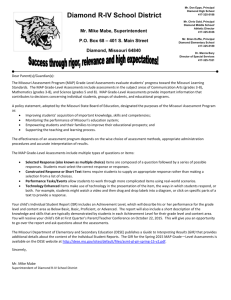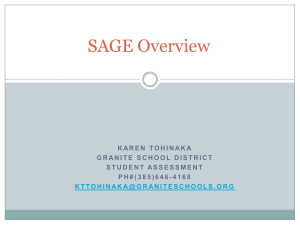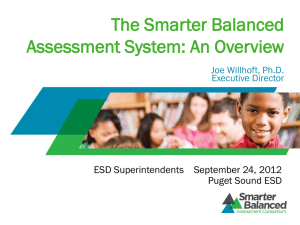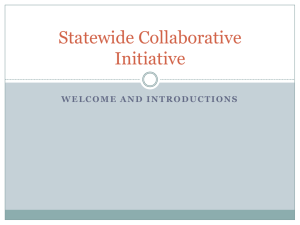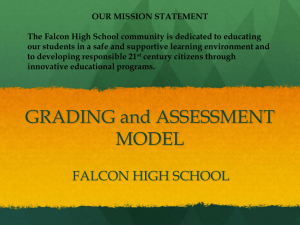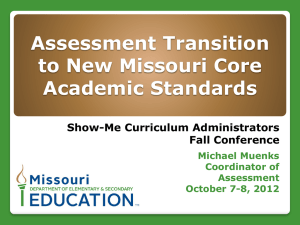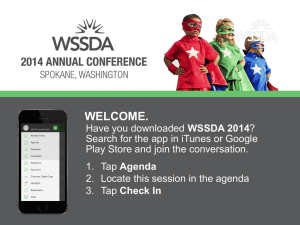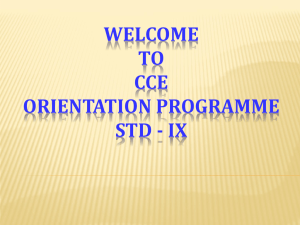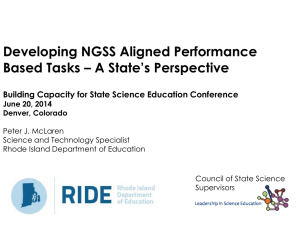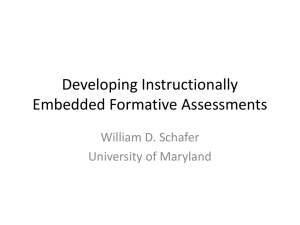Dr. Franklin`s Powerpoint 11-18-14
advertisement
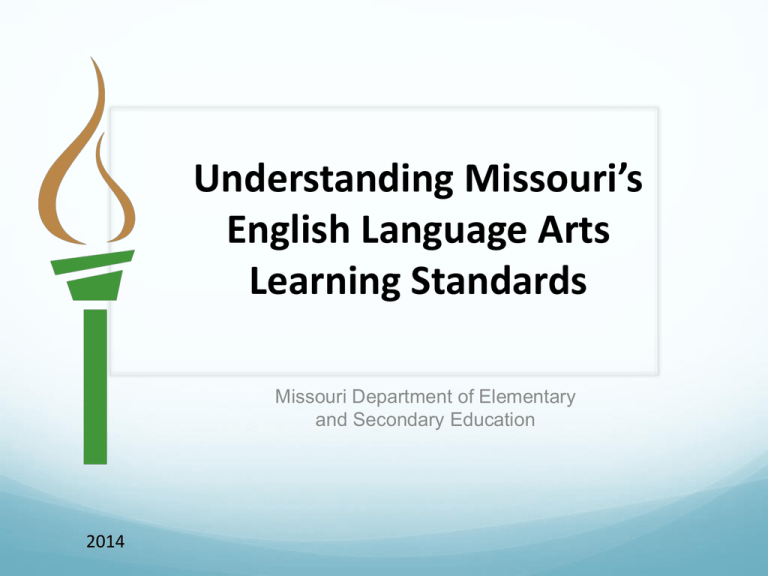
Understanding Missouri’s English Language Arts Learning Standards Missouri Department of Elementary and Secondary Education 2014 Let’s talk HB1490 • The Missouri State Board of Education adopted the Standards during their June 15, 2010 meeting. • Now referred to in Missouri as the Missouri Learning Standards (MLS) along with our math, science, and social studies standards. HB1490 Whenever standards are developed, evaluated, modified or revised…must convene groups ELA, math, science, history/governments (or for each subject for which the state develops standards) 2 work groups: K-5 (16 members) and 6-12 (17 members) Members: resident 3 years, taught or subject experience 10 years, except parents (4) Standards finished by October 1, 2015; then reviewed by board First year of an assessment doesn’t count for accreditation or evaluation Missouri Assessment Program Assessment Tools: Formative, Interim and Summative Assessment Plan (January 2014) Smarter Balanced Assessments (ELA, MA) Grades 3-8 Grade Level Science Assessments Grades 5 & 8 End-Of-Course Assessments Grades 9-12 http://dese.mo.gov/sites/default/files/asmt-guide-to-missouriassessment-program1415.pdf. A Balanced Assessment System Common Core State Standards specify K-12 expectations for college and career readiness Summative assessments Benchmarked to college and career readiness Teachers and schools have information and tools they need to improve teaching and learning Formative Assessment Practices to improve instruction Interim assessments Flexible, open, used for actionable feedback All students leave high school college and career ready Summative Assessments Full Smarter Balanced Assessments Grades 5 & 8 Shorter Smarter Balanced Assessments Grades 3,4,6 & 7 Machine-scorable/some hand-scorable Assessment Resources http://dese.mo.gov/sites/default/files/asmt-guide-tomissouri-assessment-program1415.pdf. A Balanced Assessment System Common Core State Standards specify K-12 expectations for college and career readiness Summative assessments Benchmarked to college and career readiness Teachers and schools have information and tools they need to improve teaching and learning Formative Assessment Practices to improve instruction Interim assessments Flexible, open, used for actionable feedback All students leave high school college and career ready Interim Assessments Smarter Balanced Item Bank Online Testlets Pre-Test (grades 3-8) Machine-Scorable (scored – online) Performance Events (scored – locally) A Balanced Assessment System Common Core State Standards specify K-12 expectations for college and career readiness Summative assessments Benchmarked to college and career readiness Teachers and schools have information and tools they need to improve teaching and learning Formative Assessment Practices to improve instruction Interim assessments Flexible, open, used for actionable feedback All students leave high school college and career ready What the Digital Library is NOT Lesson plans Quizzes An assessment item bank Benchmark tests Formative Assessment Process Defined Formative assessment is a deliberate process used by teachers and students during instruction that provides actionable feedback that is used to adjust ongoing teaching and learning strategies to improve students’ self- assessment, reflection and attainment of curricular learning targets/goals. Four Attributes The formative assessment process attributes are: Clarify Intended Learning Elicit Evidence Act on Evidence Interpret Evidence Digital Library Resources Assessment Literacy Modules Exemplar Instructional Modules Education Resources • Commissioned Professional Learning Modules • Resources for educators, students and families • Frame Formative Assessment within a Balanced Assessment System • Articulate the Formative Assessment Process • Highlight Formative Assessment Practices and Tools • Commissioned Professional Learning Modules • Instructional coaching for educators • Instructional materials for students • Demonstrate/support effective implementation of the formative assessment process • Focus on key content and practice from the Common Core State Standards for Mathematics and English Language Arts • High-quality vetted instructional resources and tools for educators • High-quality vetted resources and tools for students and families • Reflect and support the formative assessment process • Reflect and support the Common Core State Standards for Mathematics and English Language Arts • Create Professional Learning Communities Digital Library Functionality Allows educators to view, download, and rate resources Uses state-of-the-art tagging and search to quickly find resources by CCSS and other topics Enables educators from across the Consortium to collaborate and share their knowledge Facilitates access to resources that are stored in participating libraries Navigate to the Digital Library https://www.smarterbalancedlibrary.org Welcome Tutorial Account Digital Library: Collaboration Digital Library: Collaboration Proposed List of Commissioned Modules 30 Assessment Literacy Modules 31 ELA Instructional Modules 31 Math Instructional Modules 10 Score Report Modules Digital Library Webinars Introduction to the Digital Library http://dese.mo.gov/communications/webinar/how-usedigital-library Uploading Personnel http://dese.mo.gov/communications/webinar/digitallibrary-user-provisioning Questions Shaun Bates shaun.bates@dese.mo.gov missouridigitallibrary@dese.mo.gov Shifting Gears – High School END OF COURSE End-Of-Course Assessments Algebra 1 Geometry Algebra 2 English 2 English 1 Biology Government American History End-Of-Course Assessments Aligned to the Missouri Learning Standards (MLS) Missouri Item Bank Blueprints Practice Test Pre-Test Selected Response Performance Event The Shifts in ELA Literacy Building knowledge through content-rich nonfiction Reading, writing and speaking grounded in evidence from text both literary and informational Regular practice with complex text and its academic language Increased Exposure to Informational Text “Elementary and secondary students are not required to read enough informational text independently even though expository text makes up the vast majority of the required reading in college and the workplace.” Qualitative Measures Meaning/Purpose Level of Abstraction, Subtlety of Theme, Ambiguity of Message Text Structure Literary Texts: Plot Sequencing, Point of View, Characterization, Genre Informational Texts: Organization Linearity, Specialized Conventions Visual Elements: Text Features, Graphics/Illustrations Language Features Conventionality, Level of Literalness, Vocabulary, Sentence Structuring Knowledge Demands Life Experiences, Intertexuality, Cultural and Subject Matter Knowledge Quantitative Measures—Lexile Text Lexile Database: http://www.lexile.com/findabook/ Like any formula, however, flawed exceptions exist: Grade Band Lexile Range K-1 N/A 2-3 420-820 4-5 740-1010 6-8 925-1185 9-10 1050-1335 11-CCR 1185-1385 680L 830L Quantitative measures are less reliable with fiction (and not used at all with drama/poetry); so we also must use qualitative measures! Reader & Task Considerations Is the reader cognitively ready for this text? Is the reader proficient with the literacy strategies needed to comprehend this text? Does the reader have enough background knowledge to understand this text? Will the reader be inherently motivated by the content of this text to sustain active reading? Does this text contain mature/concerning content that might be considered inappropriate or offensive to the reader? Does this text have explicit ties to “real-world” tasks that I will ask students to engage in while reading? What standards will I focus on when teaching this text? Does this text have interdisciplinary ties to subject matter being taught in other content areas being studied by the student? Tools and Resources http://dese.mo.gov/college-career-readiness/curriculum/english-language-arts Additional Resources http://dese.mo.gov/college-career-readiness/curriculum/english-language-arts/resources Melia Franklin Melia.franklin@dese.mo.gov Twitter: @MeliaFranklin 573-751-4898 Director of English Language Arts Missouri Department of Elementary and Secondary Education
